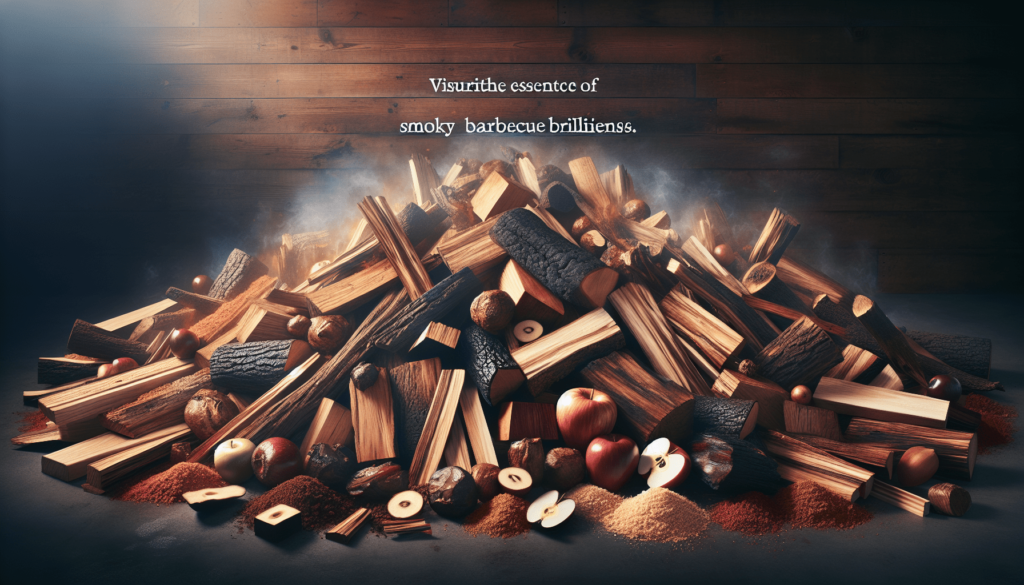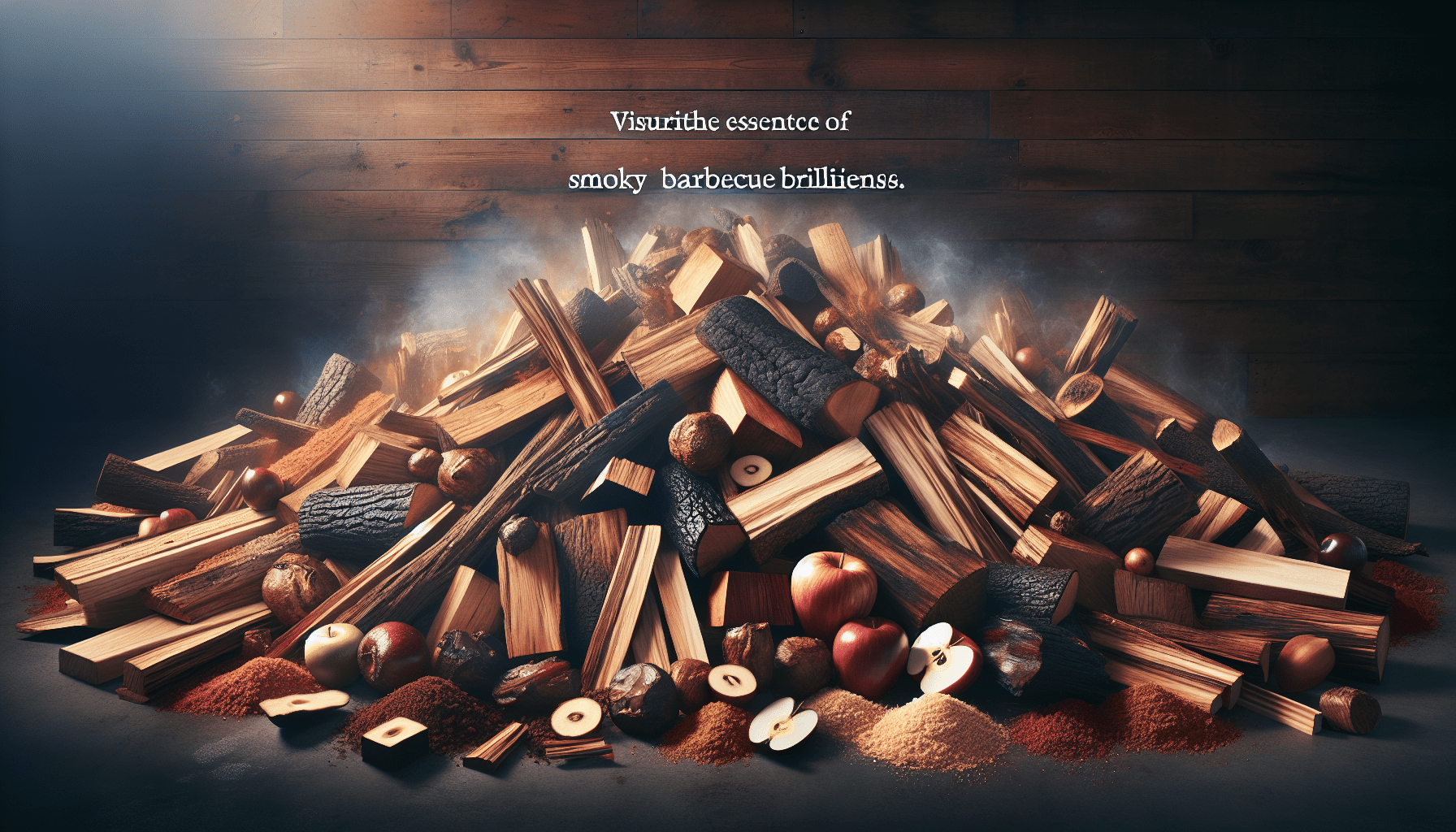Hey there! Want to know the secret behind creating the most mouthwatering, smoky barbecue flavors? Look no further than the type of wood you use for smoking. In this article, we’ll be delving into the world of pitmaster secrets and sharing with you everything you need to know about choosing the best wood for smoking. Whether you’re a seasoned pro or just starting out, we’ve got you covered. So grab a seat, put on your barbecue apron, and let’s get smokin’!
Understanding Different Types of Wood
When it comes to smoking meats, the type of wood you use can make a significant difference in flavor and overall taste. There are two main categories of wood used for smoking: hardwoods and softwoods. Each type has its own unique characteristics and attributes that can affect your smoking experience. Understanding the differences between hardwoods and softwoods is essential for selecting the right wood for your specific needs.
Hardwoods vs. Softwoods
Characteristics of Hardwoods
Hardwoods come from deciduous trees, which are trees that shed their leaves seasonally. Examples of hardwoods include oak, hickory, maple, and cherry. One notable characteristic of hardwoods is their density. These woods tend to be denser and contain fewer resins and sap than softwoods. As a result, they produce a clean and intense heat, ideal for slow cooking and smoking meats. Hardwoods also burn longer and produce a steady and consistent smoke, allowing for a more controlled and balanced cooking process.
Characteristics of Softwoods
Unlike hardwoods, softwoods come from evergreen trees that retain their leaves throughout the year. Softwood options include pine, cedar, and spruce. Due to their higher resin and sap content, softwoods ignite quickly and produce a strong and pungent smoke. Softwoods are not typically recommended for smoking meats due to their overpowering flavors, but they can be used sparingly for specific dishes that benefit from a robust smoky taste.
Pros and Cons of Each
When it comes to choosing between hardwoods and softwoods, it’s important to consider the pros and cons of each. Hardwoods are favored for their long burn time, clean smoke, and consistent heat. They provide a more subtle, yet flavorful, smoky taste that complements a variety of meats. On the other hand, softwoods offer a stronger and more pronounced smokiness but may be overpowering if not used in moderation. It’s important to keep these factors in mind when selecting wood for your smoking endeavors.
Flavor Profiles of Different Wood
The type of wood you choose can greatly influence the flavor profile of your smoked dishes. Different types of wood impart unique flavors and aromas, adding depth and complexity to your meats. It’s important to understand the flavor profiles of various woods to find the best matches for your preferred meats.
Common Types of Wood and Their Flavors
-
Oak: Oak is a versatile wood that adds a mild and smoky flavor to meats. It is commonly used with beef, pork, and poultry due to its balanced and complementary taste.
-
Hickory: Hickory is known for its strong and bacon-like flavor. It works well with beef, pork, and game meats, adding a rich and robust smokiness to the dish.
-
Maple: Maple wood offers a sweet and subtle smoky flavor that works well with poultry, pork, and vegetables. The delicate sweetness of maple complements lighter meats and enhances their natural flavors.
-
Cherry: Cherry wood provides a fruity and slightly sweet flavor that pairs excellently with pork, poultry, and fish. It adds a touch of sweetness without overpowering the meat.
Matching Wood Flavors with Meats
When selecting wood for smoking, it’s crucial to consider how the flavors of the wood will complement the specific meat you’re cooking. As a general guide:
-
Beef: For beef, stronger hardwoods like hickory or oak work well. These woods bring out the deep flavors of beef and create a smoky, robust taste.
-
Pork: The sweet and fruity flavors of woods like cherry or apple perfectly complement the natural sweetness of pork. These lighter woods provide a balanced and delicate smokiness.
-
Poultry: Poultry, such as chicken or turkey, benefits from milder woods like maple or oak. These woods enhance the poultry’s natural flavors without overpowering them.
-
Fish: Delicate fish flavors can be elevated with lighter woods such as alder or cedar. These woods provide a subtle smokiness that enhances the natural taste of the fish without overwhelming it.
Experimenting with Wood Combinations
The beauty of smoking meats is the opportunity to experiment with different wood combinations to create unique flavor profiles. Don’t limit yourself to a single type of wood; instead, try mixing various woods to achieve distinctive tastes. For example, combining hickory and applewood can create a sweet and smoky flavor that pairs well with ribs or pork shoulder. The possibilities are endless, so don’t be afraid to get creative and find your preferred wood combinations.

Choosing Wood for Specific Meats
To achieve the best results when smoking different meats, it’s important to choose the right type of wood. Each meat has its own characteristics and flavors, and selecting the appropriate wood can enhance those qualities.
Beef and Red Meat
For beef and red meats, stronger hardwoods like oak, hickory, or mesquite are excellent choices. These woods bring out the robust and savory flavors of beef, creating a mouthwatering smokiness that complements the meat. Oak provides a well-balanced flavor, while hickory adds a rich and bold taste. Mesquite adds a unique southwestern twist with its strong and earthy flavor.
Pork and Poultry
Pork and poultry benefit from lighter woods that add a delicate smokiness without overpowering their natural flavors. Fruitwoods like apple and cherry work exceptionally well with pork, providing a touch of sweetness that complements the meat’s natural juiciness. For poultry, lighter hardwoods like maple or oak work best, imparting a mild smoky taste that enhances the meat’s tenderness and juiciness.
Fish and Seafood
When smoking fish and seafood, it’s important to choose woods that provide a subtle smokiness without overwhelming the delicate flavors. Woods like alder, cedar, and fruitwoods are ideal for this purpose. Alderwood is a popular choice for fish, as it adds a light and slightly sweet flavor that enhances the natural taste of the seafood. Cedar can add a unique aroma and impart a delicate smoky taste, particularly when grilling or smoking salmon.
Vegetables and Fruits
Smoking vegetables and fruits can add a delightful smoky twist to enhance their flavors. When selecting wood for smoking these ingredients, it’s important to consider their natural sweetness and delicate textures. Fruitwoods like apple, cherry, and peach work beautifully with vegetables and fruits, adding a subtle sweetness that complements their inherent characteristics. These woods provide a well-balanced smoky flavor without overpowering the natural taste of the produce.
Factors to Consider in Wood Selection
While flavor is crucial when selecting wood for smoking, there are other factors to consider to ensure the best possible results. Keep these considerations in mind when choosing wood for your next smoking session:
Availability and Accessibility
The availability of certain wood types may vary depending on your location. Consider the accessibility of different woods and ensure you can easily obtain them for your smoking needs. Local hardwood suppliers or specialty stores may offer a wide selection of woods specific to your area.
Overall Smokiness and Intensity
Different woods have varying levels of smokiness and intensity. Some woods, like mesquite or hickory, provide a stronger flavor, while others, such as fruitwoods, offer a more subtle smokiness. Consider the overall intensity you desire in your dishes and select wood accordingly.
Aromatic vs. Mild Smokes
Some woods, like cedar or mesquite, have a more intense and aromatic smoke, while others, like alder or fruitwoods, have a milder and sweeter smoke. Consider the kind of smokiness you prefer and the specific dish you’re smoking to ensure the wood’s aroma aligns with your taste preferences.
Complementary or Contrasting Flavors
When selecting wood, think about whether you want the wood’s flavor to complement or contrast with the meat you’re smoking. Complementary flavors work harmoniously, enhancing the meat’s taste, while contrasting flavors provide a unique twist and add a new layer of complexity to the dish. Experiment with different wood flavors to find your preferred balance.

Woods to Avoid
While exploring the world of smoking, it’s crucial to be aware of woods that should be avoided due to their potentially harmful or overpowering qualities.
Toxic or Poisonous Woods
Certain woods, such as oleander or yew, are toxic and should never be used for smoking. These woods contain toxins that can be harmful if ingested or inhaled. Always do thorough research and ensure the safety of the wood you plan to use.
Resinous or Pungent Woods
Woods that contain a high resin content, such as pine or fir, can produce unpleasant and overpowering flavors when smoked. The resinous nature of these woods can create an acrid or bitter taste, inhibiting the quality of your smoked dishes. Avoid using these woods, especially for extended smoking sessions.
Woods with High Sap Content
Woods with a high sap content, like pine or spruce, can release excessive amounts of sap during the smoking process. This can result in an undesirable sticky residue on your food and smoker. It’s best to avoid these woods to prevent the occurrence of such issues.
Woods with Overpowering Flavors
While experimenting with wood combinations is encouraged, some woods have overpowering flavors that may overshadow the natural taste of the meat. Examples include mesquite, which can produce an intense and almost barbecue-like taste, or cedar, which can impart an overwhelming aroma. Use these woods sparingly and carefully in your smoking endeavors.
Preparing and Storing Wood for Smoking
To achieve the best results when smoking with wood, proper preparation and storage are essential. Follow these guidelines to ensure your wood is ready for smoking:
Seasoning and Drying Wood
Freshly cut wood needs time to cure and dry before it’s suitable for smoking. This process, known as seasoning, removes excess moisture and ensures the wood burns efficiently and produces a cleaner smoke. Ideally, the wood should be seasoned for at least 6 to 12 months to achieve the desired dryness.
Proper Storage Techniques
Once your wood is properly seasoned, it’s important to store it correctly to maintain its quality. Store your wood in a dry and well-ventilated area, preferably indoors, to prevent exposure to moisture and pests. Protect your wood from rain and extreme weather conditions, as exposure to moisture can compromise its ability to burn properly.
Using Wood Chunks, Chips, or Pellets
When it comes to smoking, you can use wood in different forms, depending on your preference and the equipment you’re using. Wood chunks are larger pieces of wood that provide a longer burn time, ideal for offset smokers or large grills. Wood chips are smaller and burn quickly, making them suitable for shorter smoking sessions or smaller grills. Wood pellets are compacted sawdust pellets that provide a consistent and controlled smoke. Choose the size and form of wood that best suits your needs and equipment.
Tips for Achieving the Best Smoke Flavor
To maximize the flavor and quality of your smoked dishes, consider these tips and techniques:
Balancing Smoke and Meat Flavors
Achieving a harmonious balance between the smoky flavor and the natural taste of the meat is key. Start with a smaller amount of wood and gradually increase if needed. This allows you to control the intensity of the smoke and ensure it enhances rather than overwhelms the dish.
Avoiding Over-Smoking
Over-smoking can result in a bitter and unpleasant taste. Use wood sparingly and avoid adding too much at once. The goal is to create a delicate and well-balanced smokiness that complements the meat, not masks it.
Controlling Temperature and Airflow
Maintaining the right temperature and airflow is crucial for successful smoking. Different types of smokers and grills require specific attention to ensure consistent heat and proper smoke circulation. Monitor your smoker or grill closely and make necessary adjustments to achieve optimal conditions.
Adding Moisture for Flavor Infusion
To enhance the infusion of flavors, you can add moisture to your smoking process. This can be done by placing a water pan or bowl filled with water, broth, or marinade near the heat source. As the liquid evaporates, it imparts moisture and flavors into the meat, resulting in a succulent and flavorful outcome.
Advanced Techniques and Tips
For those looking to take their smoking skills to the next level, consider these advanced techniques and tips:
Smoking with Wood Wraps or Planks
Using wood wraps or planks adds a unique twist to your smoking experience. Wrapping the meat in soaked cedar or other aromatic wood wraps creates a steamed effect, infusing the meat with distinct flavors. Planks, placed directly on the grill or smoker, provide a smoky and aromatic base for your meats or vegetables.
Combining Woods for Complex Flavors
Experimenting with different wood combinations can lead to complex and exciting flavors. Combining woods like apple and cherry or hickory and oak can create a multi-dimensional taste profile that takes your smoking to new heights. Be adventurous and find the combinations that suit your palate.
Cold Smoking vs. Hot Smoking
Cold smoking involves smoking at lower temperatures, below 90°F (32°C), to infuse a gentle smoke flavor without fully cooking the meat. This method is commonly used for cheese, vegetables, or fish. On the other hand, hot smoking entails cooking the meat at higher temperatures, typically above 225°F (107°C), while simultaneously applying smoke. This fully cooks the meat while imparting a robust smoky taste.
Enhancing Smokiness with Herb Infusions
Take your smoking to a new level by infusing herbs into the smoking process. Adding fresh or dried herbs, like rosemary, thyme, or sage, to the smoking chamber enhances the overall aroma and imparts a herbaceous flavor to your meats. Experiment with different herb combinations to achieve unique and enticing results.
Conclusion
Choosing the right wood is essential for achieving delicious smoked dishes that tantalize the taste buds. Understanding the characteristics of hardwoods and softwoods, as well as their respective flavor profiles, allows you to make informed choices for your smoking needs. Experiment with different wood combinations, be mindful of complementary flavors, and follow proper wood preparation and storage techniques. With the right wood selection and techniques, you’ll elevate your barbecue game and create unforgettable smoky masterpieces. Happy smoking!

